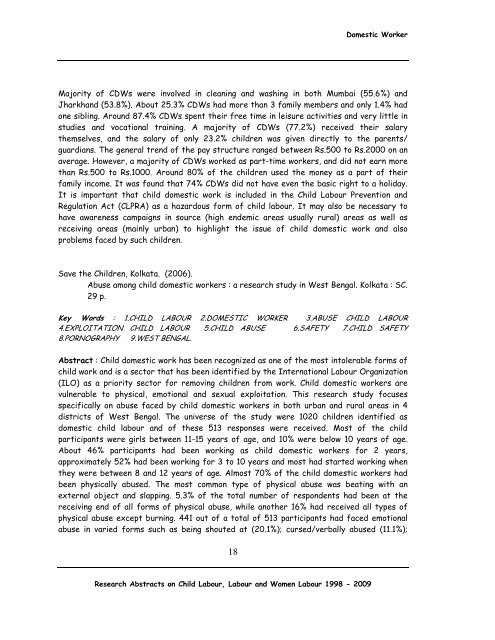Research Abstracts on Child Labour Women Labour - Nipccd
Research Abstracts on Child Labour Women Labour - Nipccd
Research Abstracts on Child Labour Women Labour - Nipccd
Create successful ePaper yourself
Turn your PDF publications into a flip-book with our unique Google optimized e-Paper software.
18<br />
<str<strong>on</strong>g>Research</str<strong>on</strong>g> <str<strong>on</strong>g>Abstracts</str<strong>on</strong>g> <strong>on</strong> <strong>Child</strong> <strong>Labour</strong>, <strong>Labour</strong> and <strong>Women</strong> <strong>Labour</strong> 1998 - 2009<br />
Domestic Worker<br />
Majority of CDWs were involved in cleaning and washing in both Mumbai (55.6%) and<br />
Jharkhand (53.8%). About 25.3% CDWs had more than 3 family members and <strong>on</strong>ly 1.4% had<br />
<strong>on</strong>e sibling. Around 87.4% CDWs spent their free time in leisure activities and very little in<br />
studies and vocati<strong>on</strong>al training. A majority of CDWs (77.2%) received their salary<br />
themselves, and the salary of <strong>on</strong>ly 23.2% children was given directly to the parents/<br />
guardians. The general trend of the pay structure ranged between Rs.500 to Rs.2000 <strong>on</strong> an<br />
average. However, a majority of CDWs worked as part-time workers, and did not earn more<br />
than Rs.500 to Rs.1000. Around 80% of the children used the m<strong>on</strong>ey as a part of their<br />
family income. It was found that 74% CDWs did not have even the basic right to a holiday.<br />
It is important that child domestic work is included in the <strong>Child</strong> <strong>Labour</strong> Preventi<strong>on</strong> and<br />
Regulati<strong>on</strong> Act (CLPRA) as a hazardous form of child labour. It may also be necessary to<br />
have awareness campaigns in source (high endemic areas usually rural) areas as well as<br />
receiving areas (mainly urban) to highlight the issue of child domestic work and also<br />
problems faced by such children.<br />
Save the <strong>Child</strong>ren, Kolkata. (2006).<br />
Abuse am<strong>on</strong>g child domestic workers : a research study in West Bengal. Kolkata : SC.<br />
29 p.<br />
Key Words : 1.CHILD LABOUR 2.DOMESTIC WORKER 3.ABUSE CHILD LABOUR<br />
4.EXPLOITATION CHILD LABOUR 5.CHILD ABUSE 6.SAFETY 7.CHILD SAFETY<br />
8.PORNOGRAPHY 9.WEST BENGAL.<br />
Abstract : <strong>Child</strong> domestic work has been recognized as <strong>on</strong>e of the most intolerable forms of<br />
child work and is a sector that has been identified by the Internati<strong>on</strong>al <strong>Labour</strong> Organizati<strong>on</strong><br />
(ILO) as a priority sector for removing children from work. <strong>Child</strong> domestic workers are<br />
vulnerable to physical, emoti<strong>on</strong>al and sexual exploitati<strong>on</strong>. This research study focuses<br />
specifically <strong>on</strong> abuse faced by child domestic workers in both urban and rural areas in 4<br />
districts of West Bengal. The universe of the study were 1020 children identified as<br />
domestic child labour and of these 513 resp<strong>on</strong>ses were received. Most of the child<br />
participants were girls between 11-15 years of age, and 10% were below 10 years of age.<br />
About 46% participants had been working as child domestic workers for 2 years,<br />
approximately 52% had been working for 3 to 10 years and most had started working when<br />
they were between 8 and 12 years of age. Almost 70% of the child domestic workers had<br />
been physically abused. The most comm<strong>on</strong> type of physical abuse was beating with an<br />
external object and slapping. 5.3% of the total number of resp<strong>on</strong>dents had been at the<br />
receiving end of all forms of physical abuse, while another 16% had received all types of<br />
physical abuse except burning. 441 out of a total of 513 participants had faced emoti<strong>on</strong>al<br />
abuse in varied forms such as being shouted at (20.1%); cursed/verbally abused (11.1%);

















